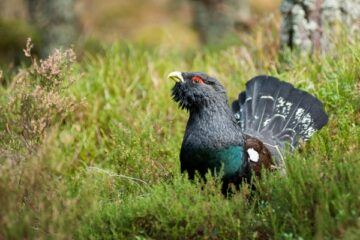A ground-breaking new study has highlighted that grouse shooting delivers significant socio-economic benefits, affirming its place as a much-valued upland land use.
Commissioned by the Scottish Government, the research shows that grouse shooting sustains many jobs and delivers high levels of local and regional investment while receiving no public funding.
The research has been published prior to the Scottish Government’s response to the independent review on grouse moor management known as the Werritty Review.
BASC Scotland Director, Dr Colin Shedden, said: “This research confirms that grouse shooting, especially driven shooting, makes an enormous socio-economic contribution across the uplands of Scotland. Despite running at a net loss, driven grouse shooting enterprises boost employment and drive rural business.
“The research also highlights how sporting enterprises are entirely self-sustaining. While conservation enterprises rely on public funding for 79% of their revenue, grouse shooting and deer stalking enterprises require no direct public funding whatsoever. The study affirms that an outstanding array of benefits are delivered on grouse moors at no expense to the public purse.
“The Scottish Government must consider the findings of this research when it formally responds to the recommendations of the independent review into grouse moor management later this year. The contribution made by grouse shooting is integral to rural Scotland, and every effort must be made to safeguard the lifeline it provides to upland communities.”
The below table from the study shows a breakdown of the socio-economic indicators by land use.
| Impact | Walked-up grouse | Driven grouse | Forestry | Woodland creation (15yr scheme)[1] | Conservation | Deer stalking | Sheep | Renewables – Hydro[2] | Renewables – Wind |
| Case study enterprises | 4 | 4 | 1 | 3 | 2 | 3 | 4 | 3 | 3 |
| Average annual capital costs | £10,465 (£2/ha) | £59,096 (£8/ha) | £173,000 (£41/ha) | £32,924 (£151/ha) | £153,815 (£10/ha) | £45,624 (£2/ha) | £16,341 (£7/ha) | £1.4m (build cost); (£93,444 over 15yrs) (£4,024/kW) | £89m (developer) costs (n/a) |
| Average running costs (incl. staff costs) | £61,247 (£11/ha) | £219,292 (£30/ha) | £102, 056 (£24/ha) | £26,548 (£122/ha) | £480,284 (£29/ha) | £182,813 (£10/ha) | £87,019 (£36/ha) | £37,172 (n/a) | Est. £4.8-5m for larger examples (n/a) |
| Average revenue | £26,281 (£5/ha) | £147,916 (£20/ha) | £220,000 (£53/ha) | £63,039 (£290/ha) | £313,816 (£19/ha) | £87,826 (£5/ha) | £146,971 (£61/ha) | £192,280 (£552/kW) | £334,000 (£245/ha wind farm or £55/ha estate) |
| Hectares per FTE | 4,685 | 1,446 | 4,000 | n/a | 2,100 | 4,005 | 1,793 | n/a | n/a |
| Net balance (before capital) | -£34,966 (-£6/ha) | -£71,375 (-£10/ha) | £117,944 (£28/ha) | £36,491 (£168/ha) | -£166,468 (-£10/ha) | -£94,987 (-£5/ha) | £59,952 (£25/ha) | £148,878 (£428/kW) | n/a |
| Net balance (capital included) | -£45,431 (-£8/ha) | -£130,472 (-£18/ha) | -£55,056 (-£13/ha) | £3,567 (£16/ha) | -£320,283 (-£20/ha) | -£140,611 (-£7/ha) | £43,611 (£18/ha) | £92,606 (£266/kW) | n/a |
| Average revenue (%) from public funding[3] | 0% | 0% | 47% | 86% | 79% | 0% | 66% | 69% | n/a |
| Level of local-regional spending | Moderate/ High | High | Low/ Moderate | Low/ Moderate | Moderate/ High | High | High | Moderate/ High | Moderate |
| Revenue per £1 spent | £0.43 | £0.67 | £2.15 | £2.37 | £0.65 | £0.48 | £1.69 | £1.93 (£4.43 after payback) | n/a |
[1] Data relates to annual costs and revenues averaged over 15 years. Average annual costs and per/ha costs are considerably lower over a full rotation.
[2] Average annual running costs and revenues exclude the initial capital costs – but the net balance including repayment of capital investment is shown over 15 years.
[3] The public funding contributions only relate to the specified land use and a low or zero percent figure does not imply that the estate within which the land use/enterprise sits did not receiving any public funding in relation to other activities (e.g. farming, conservation). Furthermore, some estate land uses which may receive public funding (e.g. sheep grazing) overlap with, complement, and form part of the management of the moorland area over which grouse shooting and other activities may take place. Landowners may also receive public funding for deer fencing but this is generally recorded as relating to forestry management as opposed to deer revenues.



